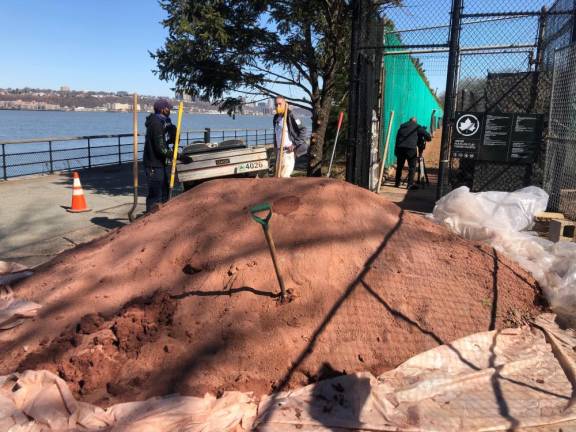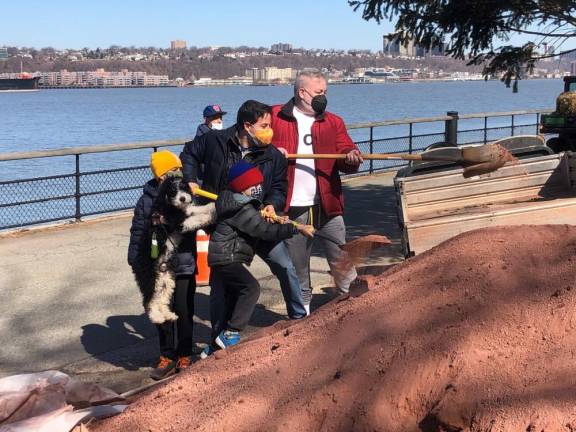Fresh Red Clay Signals Spring at Riverside Park Tennis Courts
Riverside Clay Tennis Association prepares for the upcoming season after an unusual year


For the first time in a while, Riverside Clay Tennis Association staff and volunteers dug their shovels into a huge pile of red clay — seven tons of it, to be precise — to begin resurfacing the tennis courts in Riverside Park near 96th Street.
The undertaking, which began in earnest on March 20 with a celebration dubbed “Clay Date,” marks the start of a new season for many in the Upper West Side tennis community. “It means that brighter days are ahead,” said Dan Garodnick, president of Riverside Park Conservancy, in a press release about the event. “And we are definitely ready for them this year.”
Honoring the official “Clay Date” is a new tradition that started in 2019. But 2020’s “Clay Date” never happened — and the courts went without a fresh layer of red clay — due to COVID-19. Over the past year, the Riverside Park clay tennis courts experienced a spike in use, according to RCTA’s soon-to-be Executive Director, Tim Heath. This spring, the re-emergence of the red clay pile near the edge of the Hudson River has been welcomed with open arms by locals eager to keep playing.
“Secret Sauce”
Over the next few weeks, the RCTA — a nonprofit which oversees the sole outdoor public red clay tennis courts in the city — will fully resurface six of the ten courts in preparation for a mid-April reopening, according to Heath. He explained that the process involves tilling, aerating and smoothing the clay before positioning new court lines, which are carefully measured and nailed in place.
Still, there are certain tricks of the trade that remain under wraps — otherwise known as the “secret sauce,” according to Heath, who’s served as RCTA’s associate director since 2017.
The clay comes from New Jersey, he said, and is a rich, earthy red-brown hue.
In a normal year, the RCTA team would resurface only two or three courts. The clay material, however, is resilient.
“Red clay is bulletproof,” Heath said. “It’s a very durable surface.”
Certain rules of play help keep the courts in tip-top shape, too, according to Upper West Sider Joyce Hansen, who’s hit on the Riverside Park clay courts on and off since the early 90s with her husband, Dale. She explained that players are expected to brush the courts after use as a courtesy to those next in line.
Recently, the pair has taken to biking by the courts, where they’ve noticed the resurfacing efforts underway. Prior to the pandemic, they’d play at the courts three times a week.
“The amount of professionalism they bring,” Joyce said, “to resurfacing and maintaining those courts is, you know, quite extraordinary.”
Both the Hansens and Moira Lubbock, another tennis player from the Upper West Side who’s played at the Riverside Park courts for nearly three decades, agree that the clay surface is gentler on the body than what one could expect from playing on hard courts.
Lubbock added that clay courts can make for a more entertaining and unpredictable game, too.
“I’ve always kind of liked the bounce of the ball,” she said. “It’s just interesting to get some really unusual bounces.”
The location of the courts near the Hudson River and the surrounding landscaping, which is maintained by the RCTA, are extra benefits, in Lubbock’s eyes.
A Spike in Activity
Rather than opening according to schedule last spring, the clay courts didn’t see any activity until June. Still, Heath noticed an uptick in interest in the sport overall during the pandemic reflected in an “increase in play” at the RCTA courts.
Over the past year, “tennis participation” rose by over 20 percent across the country, according to data presented in a press release from the United States Tennis Association. In the city, players could hit on public courts for free — a rarity, since normally, the New York City Department of Park & Recreation sells full-season permits for $100 (or at a lesser cost, for those who qualify) or single-play permits for $15, and requires such permits from early April through the end of November.
The Riverside Park clay courts typically close for the season by the beginning of December, according to Heath. This year, players will once again need permits to use the courts.
While Lubbock said that she didn’t hit nearly as much as usual during the past pandemic year, the Hansens increased their commitment to the sport by playing four to five times each week.
All agree that the courts are normally in high demand and that this spring looks promising — especially since tennis, in their outlook, is a pandemic-friendly sport.
“There’s still a tremendous amount that we do not know,” Lubbock said of COVID-19 transmission. “But I think given what we do know, I think playing tennis outdoors is a perfectly safe activity.”